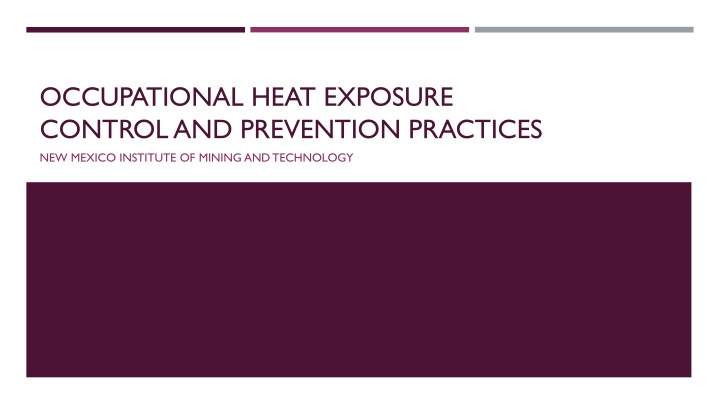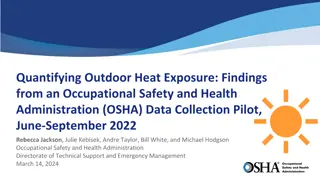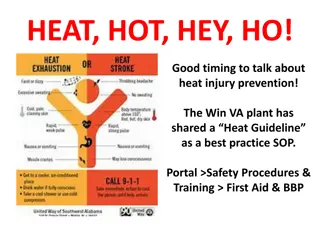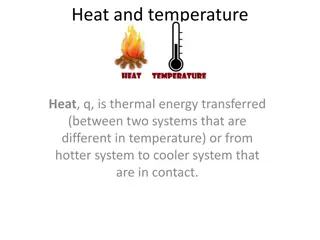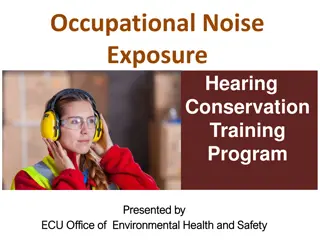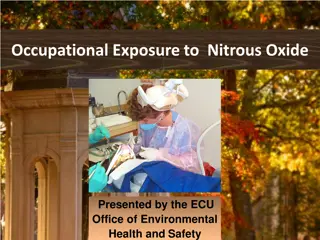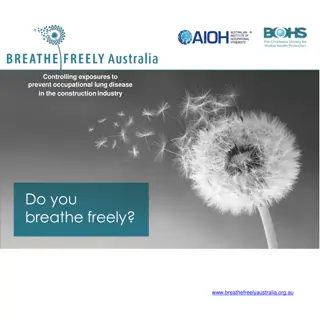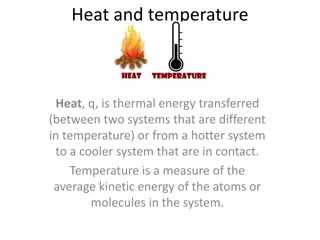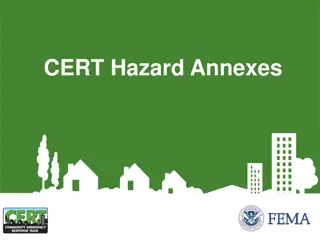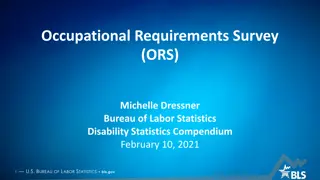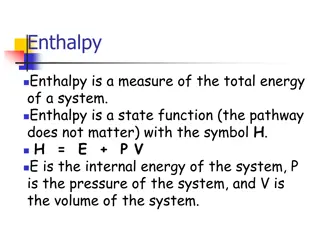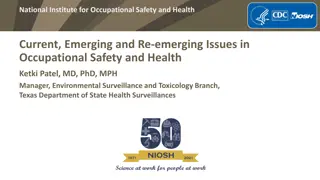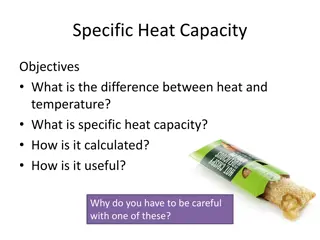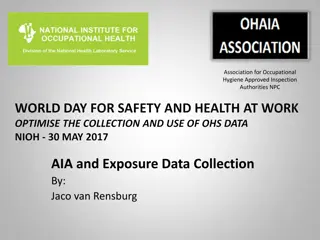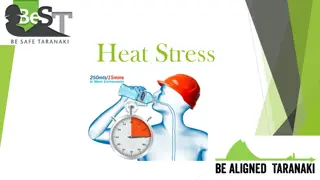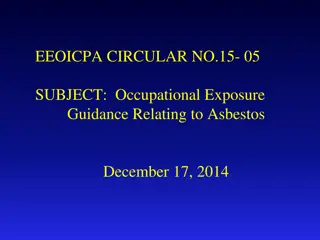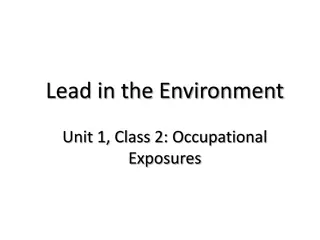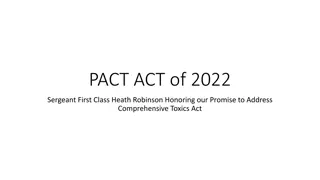Occupational Heat Exposure Control and Prevention Practices
Occupational Heat Exposure Control and Prevention Practices at the New Mexico Institute of Mining and Technology covers training for workers exposed to excessive heat, pre-test evaluation, objectives focusing on heat stress and exposure, understanding heat and heat stress, human body's response to heat, and personal and environmental factors affecting heat exposure. The materials aim to educate on heat stress, hazards, measurement, prevention, and understanding of how the human body reacts to heat.
Download Presentation

Please find below an Image/Link to download the presentation.
The content on the website is provided AS IS for your information and personal use only. It may not be sold, licensed, or shared on other websites without obtaining consent from the author.If you encounter any issues during the download, it is possible that the publisher has removed the file from their server.
You are allowed to download the files provided on this website for personal or commercial use, subject to the condition that they are used lawfully. All files are the property of their respective owners.
The content on the website is provided AS IS for your information and personal use only. It may not be sold, licensed, or shared on other websites without obtaining consent from the author.
E N D
Presentation Transcript
OCCUPATIONAL HEAT EXPOSURE CONTROL AND PREVENTION PRACTICES NEW MEXICO INSTITUTE OF MINING AND TECHNOLOGY
DISCLAIMER The training and educational materials were produced under grant SH- 05048-SH8 from the Occupational Safety and Health Administration, U.S. Department of Labor. It does not necessarily reflect the views or policies of the U.S. Department of Labor, nor does mention of trade names, commercial products, or organizations imply endorsement by the U.S. Government. 2 TRAINING FOR WORKERS WHO ARE EXPOSED TO EXCESSIVE HEAT
PRE-TEST The purpose of the pre-test is to evaluate your knowledge about heat stress and heat exposure consequences It will help you know what will be covered during the training The pre-test will be compared to a post-test and helps us determine how we did during the training 3 TRAINING FOR WORKERS WHO ARE EXPOSED TO EXCESSIVE HEAT
OBJECTIVES Heat Stress Heat Exposure and Health Hazards Heat Exposure and Safety Hazards Heat Stress Measurement Heat Stress Exposure Control and Prevention www.osha.com 4 TRAINING FOR WORKERS WHO ARE EXPOSED TO EXCESSIVE HEAT
PART 1 UNDERSTANDING HEAT What is heat? What is heat stress? Why is it important? 5 TRAINING FOR WORKERS WHO ARE EXPOSED TO EXCESSIVE HEAT
HEAT STRESS The net heat load to which a worker is exposed Heat Sources External heat load Internal heat load Temperature Humidity Clothing (1) Environmental heat Metabolic heat Physical activity (2) Metabolic heat (3) Physical activities (4) Clothing insulation 6 TRAINING FOR WORKERS WHO ARE EXPOSED TO EXCESSIVE HEAT
HOW HUMAN BODY WORKS? Our body has mechanism to reject heat and control body temperature Core temperature must remain constant How are body reacts Sweat rate Heart rate Blood pressure Skin temperature Core temperature Increase Increase Decrease Increase Increase 7 TRAINING FOR WORKERS WHO ARE EXPOSED TO EXCESSIVE HEAT
PERSONAL AND ENVIRONMENTAL FACTORS Personal Factors Environmental Factors Personal factors Age Gender Fitness Obesity Past history of heat illness History of other diseases Experience and skills Knowledge Mental capacity Personal behaviors Life style Drug and alcohol use Medication use Smoking Sleep quality Environmental factors Air temperature Humidity Wind speed Radiant temperature Behavioral factors Level of activity Clothing 8 TRAINING FOR WORKERS WHO ARE EXPOSED TO EXCESSIVE HEAT
PART 11 HEAT IS A HEALTH HAZARD ARE YOU PROTECTED? 9 TRAINING FOR WORKERS WHO ARE EXPOSED TO EXCESSIVE HEAT
HEAT STRESS HEALTH HAZARDS Health Hazards Discomfort Heat syncope Heat Heat rash Heat cramp Heat stroke exhaustion 10 TRAINING FOR WORKERS WHO ARE EXPOSED TO EXCESSIVE HEAT
HEAT STRESS HEALTH HAZARDS (HANDOUT 1) What you need to know: Causes Signs and symptoms Risks First aid and treatment Prevention 11 TRAINING FOR WORKERS WHO ARE EXPOSED TO EXCESSIVE HEAT
HEAT EXHAUSTION VS HEAT STROKE Heat Exhaustion Heat Stroke Faint or dizzy Excessive sweating Cool, pale, or clammy skin Nausea or vomiting Rapid, weak pulse Muscle cramps Headache No sweating Nausea or vomiting Rapid, strong pulse May lose consciousness Signs Signs CALL 9-1-1 Notify your supervisor Move the person to a cooler area DO NOT GIVE FLUIDS Notify your supervisor Get to a cooler area Drink water (if you are fully conscious) Use cold cloths or compresses What to What to do do 12 TRAINING FOR WORKERS WHO ARE EXPOSED TO EXCESSIVE HEAT
CLASS DISCUSSION HEAT ILLNESSES How can we prevent heat stress illnesses? 1 11 111 111 111 TRAINING FOR WORKERS WHO ARE EXPOSED TO EXCESSIVE HEAT 13
WATER REST - SHADE Allow your body to rest and cool down 14 TRAINING FOR WORKERS WHO ARE EXPOSED TO EXCESSIVE HEAT www.osha.com
HYDRATION PROGRAM It is important to consume pure and cool potable water throughout the shift Employees Employers Frequently drink water and not wait until thirsty at least 1 cup every 15-20 minutes Water quantities need to be sufficient and at least 1 quart per worker per hour for the entire shift Locate water containers as close as possible Ensure water containers are clean and sanitary Ensure water containers are filled at a sanitary location Do not use water from irrigation, sprinklers or fire systems Provide disposable cups Do not share cups and dispose properly Develop and encourage a hydration program 15 TRAINING FOR WORKERS WHO ARE EXPOSED TO EXCESSIVE HEAT
MONITORINGOF URINE COLOR Urine color chart Normal urine should be pale yellow Darker urine can indicate dehydration Some diets, medications and illnesses may affect results 16 TRAINING FOR WORKERS WHO ARE EXPOSED TO EXCESSIVE HEAT Adapted from NIOSH
ACCLIMATION Physiological and Psychologic adjustment to heat exposure Develop the capability of workers to perform their activities at a job in the hot environment Decrease the risk of heat-related illnesses and hazardous behaviors Increase the efficiency of sweating Adjust replacing the water loss due to sweating 17 Adapted from NIOSH TRAINING FOR WORKERS WHO ARE EXPOSED TO EXCESSIVE HEAT
PART 11I HEAT IS A SAFETY HAZARD ARE YOU PROTECTED? 18 TRAINING FOR WORKERS WHO ARE EXPOSED TO EXCESSIVE HEAT
HEAT STRESS SAFETY HAZARDS Safety Hazards Carelessness Loss of concentration Impaired mental capacity Inability to make decision Misapplication of PPE Fatigue 19 TRAINING FOR WORKERS WHO ARE EXPOSED TO EXCESSIVE HEAT
FATIGUE A state of extreme tiredness resulting from mental or physical exertion INCREASE - Risk taking - Errors in judgement - Forgetfulness - Accident rate - Decision making ability - Performance - Reaction time Attention DECREASE TRAINING FOR WORKERS WHO ARE EXPOSED TO EXCESSIVE HEAT 20
FATIGUE IMPORTANT FACTORS FATIGUE HAS NOTHING TO DO WITH YOUR JOB SKILLS LEVEL Sleep quality Diet State of health Alcohol Knowledge High temperature High noise Long shifts Repetitive tasks Limited visibility Personal Environmental TRAINING FOR WORKERS WHO ARE EXPOSED TO EXCESSIVE HEAT 21
FATIGUE PREVENTION AND CONTROL Employees Employers Eat well Eat a healthy diet that gives you sufficient energy throughout your shift Train your workers and ensure they have enough knowledge about fatigue Stay positive during your job Vary job tasks to avoid repetition Stay alert and look after your co-workers Encourage breaks during long shifts Ask your employers for training and educational materials Introduce shorter shifts specially to those who are under direct sun light Try to enjoy your job and take a break if necessary Ensure that the environment is safe Encourage your workers to communicate with you!! Communicate!!! 22 TRAINING FOR WORKERS WHO ARE EXPOSED TO EXCESSIVE HEAT
PERSONAL PROTECTIVE EQUIPMENT (PPE) ARE YOU PROTECTED? PPE requirements are different from site to site The main aim of using PPE is to protect yourself against health and safety hazards You must be trained in order to use the PPE properly PPE is the least effective method of controlling and preventing the hazards However, it reduces occupational injuries and illnesses TRAINING FOR WORKERS WHO ARE EXPOSED TO EXCESSIVE HEAT 23
MISAPPLICATION OF PERSONAL PROTECTIVE EQUIPMENT (PPE) DO s DON Ts Do not remove your PPE when it is required PPE must be worn at all time at jobs Follow the instruction for proper use of PPE Do not alter your PPE Take several breaks during the shift hours Do not rest in the areas where PPE is required In in areas that use of PPE is not required Do not remove somebody else s PPE unless you are told by your supervisor Communicate with your supervisor about possible hazards Do not wear dark cloths Look after your coworkers and report misapplication of PPE Do not take shortcuts Drink plenty of water 24 TRAINING FOR WORKERS WHO ARE EXPOSED TO EXCESSIVE HEAT
CLASS DISCUSSION PPE - Application and misapplication 1 11 111 111 111 TRAINING FOR WORKERS WHO ARE EXPOSED TO EXCESSIVE HEAT 25
PART IV Heat Stress Measurement HEAT STRESS INDEX 26 TRAINING FOR WORKERS WHO ARE EXPOSED TO EXCESSIVE HEAT
THERMAL COMFORT EVALUATION Subjective Evaluation (Asking) The traditional 7-point status scale: cold | cool | slightly cool | neutral | slightly warm | warm | hot An alternative action scale: Would you prefer: to be warmer | no change | to be cooler - A post-occupancy evaluation (POE) tool If workers are in the environment being evaluated 27 TRAINING FOR WORKERS WHO ARE EXPOSED TO EXCESSIVE HEAT
MEASUREMENT OF HEAT STRESS Heat Stress Index Heat stress index is an indicator Each heat stress index is developed for a specific application (there are over 160 heat indices) It takes into account some of the environmental and behavioral parameters Provides risk level and possibly work-rest cycles according to the level of danger It can be used as baseline for heat exposure safety measures 28 TRAINING FOR WORKERS WHO ARE EXPOSED TO EXCESSIVE HEAT
NECESSARY STEPS Temperature, humidity, wind speed, M Use table of equation to calculate the index number Correct for level of activity, clothing, and exposure conditions MEAUSURE CALCULATE ACT C Apply the recommended actions Provide feedback to the supervisor A 29 TRAINING FOR WORKERS WHO ARE EXPOSED TO EXCESSIVE HEAT
HEAT INDEX (HANDOUT II) Heat Index (OSHA recommended index) DO s and DON Ts Understand the Heat Index and learn how to calculate it Always follow the instructions according to the safety plans Implement safety measures if work in direct sun light Communicate with your supervisor and your coworkers about possible hazards DO NOT only rely on Heat Index. People react differently to the heat exposure DO NOT skip rest cycles when necessary DO NOT work by yourself if risk level is high Heat Index is an indicator Outdoor workers are exposed to higher level of heat exposure if work in direct sun light Take into account the effects of PPE, level of activity, and impermeable cloths The reaction to heat exposure is different from individual to individual 30 TRAINING FOR WORKERS WHO ARE EXPOSED TO EXCESSIVE HEAT
HEAT INDEX MOBILE APP A visual indicator of the current heat index and associated risk levels specific to your current geographical location Precautionary recommendations specific to heat index-associated risk levels An interactive, hourly forecast of heat index values, risk level, and recommendations for planning outdoor work activities in advance Editable location, temperature, and humidity controls for calculation of variable conditions Signs and symptoms and first aid information for heat-related illnesses 31 TRAINING FOR WORKERS WHO ARE EXPOSED TO EXCESSIVE HEAT Adapted from NIOSH
PARAMETERS THAT CANNOT BE MEASURED Personal Factors Personal factors Personal behaviors The personal factors cannot be included in a thermal model Age Gender Fitness Obesity Past history of heat illness History of other diseases Experience and skills Knowledge Mental capacity Life style Drug and alcohol use Medication use Smoking Sleep quality It is critical to understand that body response to heat exposure is different from person to person 32 TRAINING FOR WORKERS WHO ARE EXPOSED TO EXCESSIVE HEAT
SELF-PACED WORK The self-paced workers are well-informed, educated individuals who can regulate their work-rate and is not subject to supervisor pressure 33 TRAINING FOR WORKERS WHO ARE EXPOSED TO EXCESSIVE HEAT
IMPORTANCE OF TRAINING Training Regular training Training during specific time Educational materials Self-learning, self-awareness Sings, posters, pamphlets, 34 TRAINING FOR WORKERS WHO ARE EXPOSED TO EXCESSIVE HEAT
IMPORTANCE OF COMMUNICATION Employer Trust your worker Conduct subjective evaluation Educate your worker Take alternative actions Modify tasks and schedules Employees Communicate with you employers Speak up Trust you employer 35 TRAINING FOR WORKERS WHO ARE EXPOSED TO EXCESSIVE HEAT
BUDDY SYSTEM Develop a buddy program at workplaces Watch any sign or symptoms Communicate with your crew if you see any signs Encourage your crew to rest if necessary Provide information to your supervisor Provide first aid if you received proper training 36 TRAINING FOR WORKERS WHO ARE EXPOSED TO EXCESSIVE HEAT
THANK YOU! Take Post-Test and Complete Survey The post-test and survey helps us determine if we did a good job or need to make improvements in certain areas 37 TRAINING FOR WORKERS WHO ARE EXPOSED TO EXCESSIVE HEAT
